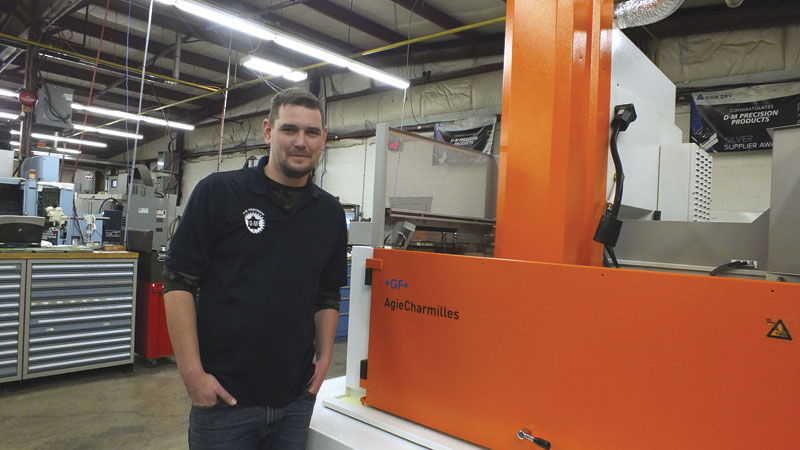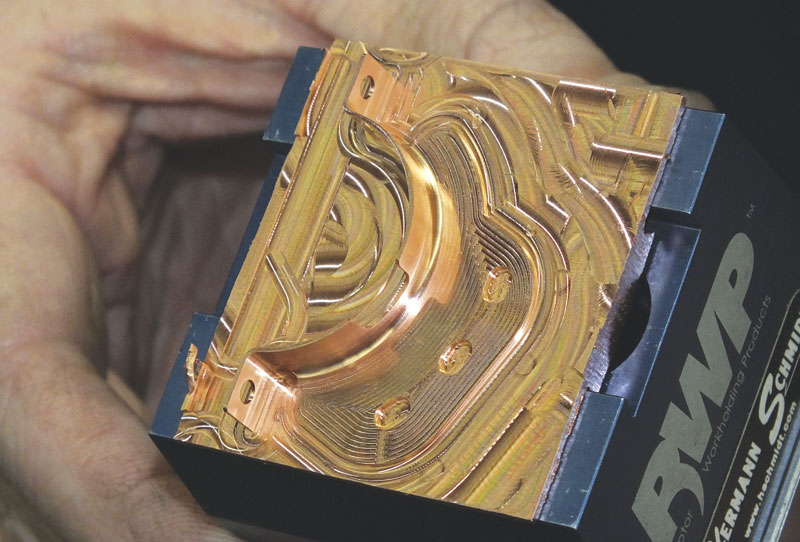by Mary Scianna
The Problem: Missing out on part families from existing customers
The Solution: EDM technology to capture more business
Ontario shop carves aluminum machining niche with EDM technology
2011 marked a turning point for D-M Precision Products. It was the year company management decided to invest in EDM technology.
Today, the 929 sq m (10,000 sq ft) custom machine shop in Dunnville, ON, formed by Reinhold Plath in 1952, operates three EDM machines–two die sinkers and one wire–from GF Machining Solutions (GFMS), and the EDM business continues to grow, says Chad Plath, plant manager and Reinhold’s grandson.
D-M Precision specializes in tight tolerance, small, complex parts primarily for the medical, telecommunications, science research and defence imaging markets.
“We were turning and milling components for our customers, but we were missing out on the 20 per cent of the family of components that are machined with EDMs. We looked at EDM as a complement to the milling side of the business for the customers we were already serving in these markets,” says Plath.
H e adds that EDM machining has also opened doors to new opportunities.
e adds that EDM machining has also opened doors to new opportunities.
“We’ve expanded our customer base and EDM is giving us more opportunities in different markets.”
D-M Precison Products’ founder Reinhold went into partnership with his son Ben Plath in the 1970s. Today, Ben’s children are now involved in the business. His daughter Anita Basilio oversees administration and son Chad runs the shop floor that houses a variety of machine tools, including Haas and Matsuura milling centres, Nakamura-Tome turning centers, Hardinge lathes and the GFMS EDM machines. The shop is ISO-9000 and Controlled Goods certified.
A learning curve
D-M purchased its first GFMS AgieCharmilles die sinker, a Form 20 machine, in 2011 and shortly after purchased a GFMS AgieCharmilles wire EDM, the Form 20. Its most recent machine, purchased in 2015, is a second die sinker, the AgieCharmilles Form 30, designed with a wider machining envelope. The machines were purchased from machine tool distributor Elliott Matsuura Canada.
Even though the shop has been using EDM technology for five years, Plath says it’s still a learning curve.
 “We’ve been at this for five years now and there’s a huge learning curve. We went with the AgieCharmilles machines because we wanted good technology but a big reason was the service that we get from Elliott Matsuura. We have other machines the company has put in for us and the people at Elliott are very knowledgeable. Elliott has a great EDM department and it was important for us to have support because we weren’t just learning about how to handle a new machine, we were learning about a whole new machining technology. We wanted a partner who could understand the direction we wanted to go with this technology and the capability to help us reach our goal.”
“We’ve been at this for five years now and there’s a huge learning curve. We went with the AgieCharmilles machines because we wanted good technology but a big reason was the service that we get from Elliott Matsuura. We have other machines the company has put in for us and the people at Elliott are very knowledgeable. Elliott has a great EDM department and it was important for us to have support because we weren’t just learning about how to handle a new machine, we were learning about a whole new machining technology. We wanted a partner who could understand the direction we wanted to go with this technology and the capability to help us reach our goal.”
A big focus of that EDM learning curve was developing strategies to maximize efficiencies.
“Running 24/7 and on weekends is the optimum time for EDMs because the machining cycles are typically long, so we’ve focused on maximizing efficiencies in this area by putting as many parts and families of parts on the machines as possible and installing part fixturing and a 3R workholding system.”
Plath refers to the EDM department as being “semi-automated.” While parts are manually loaded and unloaded, D-M uses a pallet system on which parts are loaded.
“It eliminates human error. We also cut electrodes on the wire EDM using the same palletized system because again, it takes the human error out of the process because the palletized system has reference points and coordinates when you load them.”
The recent GFMS AgieCharmille Form 30 die sinker was part of the strategy to maximize machining efficiencies. A larger machine allows D-M to increase the number of jobs on a machine at one time.
“So now we’re able to run two or three jobs at one time. If we have one job on the go and there’s enough carousel space for more parts or more electrodes, we’ll add them. We have cycle times that last a week running almost 40 hours unattended,” explains Plath.
An equally formidable challenge is machining aluminum on an EDM machine. It’s a challenge the company has turned into a niche market, and it has become recognized for its quality machining of aluminum parts with tight tolerances as low as 32 Ra.
“Defining anything below 32 Ra is still a challenge. We aim between 32 and 45 Ra for most parts. We sometimes get a requirement to go below 32 but if it’s for aluminum, it can be problematic because you may end up with carbon deposits that build up in the material and create part finish problems,” says Plath.
One person who knows all about EDM technology is D-M’s EDM specialist Mathew LaHay, who, at previous employers, has run AgieCharmilles EDMs for more than 13 years.
“EDM is a fairly slow process so if you can mill or turn a part, do it that way. Where EDM is advantageous is for sharp corners and difficult-to-reach components, like internal counter bores or through-holes on an inside wall. Some of the requirements are for ten thou maximum radius at the bottom of a pocket and features like that are easier to produce on an EDM.”
LaHay says he has seen a “huge difference” in EDM technology since he first started to work with them.
“Today’s machines offer much more flexibility in how you can produce sharp corners on a part and in using multiple electrodes. With one machine we have an electrode on either side of it and a C axis on the head, which can rotate, so we’re able to add corrections where needed. So if a part isn’t milled perfectly square, we can adjust for that on the EDM.”
Plath says he expects business to continue to grow but the current machine shop setup will be able to accommodate growth in the foreseeable future.
“At this point we’re comfortable with the three EDMs we have. If we continue to maximize the number of parts we machine on them, we can get a lot done. It’s not a bottleneck for us. Also, since we just upgraded our QC department with a new Zeiss CMM, that has helped because we now have two CMMs that can handle any increased throughput from the shop floor.” SMT
